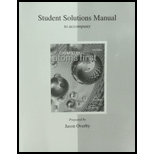
Concept explainers
(a)
Interpretation:
Balanced equation for sodium bicarbonate thermal decomposition and confirmation of carbon dioxide production from sodium bicarbonate thermal decomposition has to be explained.
Concept introduction:
Balanced chemical equation: In a
Aqueous calcium hydroxide solution is known as lime water. When carbon dioxide gas passes though lime water white precipitate is formed due to the formation insoluble calcium carbonate.
To balance: The equation of thermal decomposition of
(b)
Interpretation:
Balanced equation for sodium bicarbonate thermal decomposition and confirmation of carbon dioxide production from sodium bicarbonate thermal decomposition has to be explained.
Concept introduction:
Balanced chemical equation: In a chemical reaction the overall mass of the starting materials should be equal to the overall mass of the products. This is governed by the law of conservation of mass.
Aqueous calcium hydroxide solution is known as lime water. When carbon dioxide gas passes though lime water white precipitate is formed due to the formation insoluble calcium carbonate.
To prove: carbon dioxide production from sodium bicarbonate thermal decomposition
Want to see the full answer?
Check out a sample textbook solution
Chapter 25 Solutions
Student Solutions Manual For Chemistry: Atoms First
- 6. Why would magnesium inhibit the formation of CaC2O4 crystals?arrow_forwardWhy is CO considered poisonous ?arrow_forward(a) What are the different oxidation states exhibited by the lanthanoids? (b) Write two characteristics of the transition elements. (c) Which of the 3d-block elements may not be regarded as the transition elements and why?arrow_forward
- In acidic solution, hydrogen peroxide reacts with Fe2+ to produce Fe3+ and H2O. Write a balanced equation for this reaction.arrow_forwardWrite the synthesis and important reactions of Ferrocenearrow_forward(a) In the industrial production of iron, what is the reducing substance loaded into the blast furnace? (b) In addition to fur-nishing the reducing power, what other function does this sub-stance serve? (c) What is the formula of the active reducing agent in the process? (d) Write equations for the stepwise reduc-tion of Fe₂O₃ to iron in the furnacearrow_forward
- What is the oxidation number of S in the compound Na₂S₂O₅?arrow_forwardWhich of the following statements about titanium dioxide is false? A. The titanium has a d0s0 electron configuration B. It has the sodium chloride structure. C. It has a full valence band. D. It is white E. It can be synthesised by thermal decomposition of titanium isopropoxide in airarrow_forwardHow does the Mineral Family- Oxides is used in everyday life and in Engineering activities?arrow_forward
 Chemistry: The Molecular ScienceChemistryISBN:9781285199047Author:John W. Moore, Conrad L. StanitskiPublisher:Cengage Learning
Chemistry: The Molecular ScienceChemistryISBN:9781285199047Author:John W. Moore, Conrad L. StanitskiPublisher:Cengage Learning General Chemistry - Standalone book (MindTap Cour...ChemistryISBN:9781305580343Author:Steven D. Gammon, Ebbing, Darrell Ebbing, Steven D., Darrell; Gammon, Darrell Ebbing; Steven D. Gammon, Darrell D.; Gammon, Ebbing; Steven D. Gammon; DarrellPublisher:Cengage Learning
General Chemistry - Standalone book (MindTap Cour...ChemistryISBN:9781305580343Author:Steven D. Gammon, Ebbing, Darrell Ebbing, Steven D., Darrell; Gammon, Darrell Ebbing; Steven D. Gammon, Darrell D.; Gammon, Ebbing; Steven D. Gammon; DarrellPublisher:Cengage Learning Chemistry: Principles and PracticeChemistryISBN:9780534420123Author:Daniel L. Reger, Scott R. Goode, David W. Ball, Edward MercerPublisher:Cengage Learning
Chemistry: Principles and PracticeChemistryISBN:9780534420123Author:Daniel L. Reger, Scott R. Goode, David W. Ball, Edward MercerPublisher:Cengage Learning Chemistry: Principles and ReactionsChemistryISBN:9781305079373Author:William L. Masterton, Cecile N. HurleyPublisher:Cengage Learning
Chemistry: Principles and ReactionsChemistryISBN:9781305079373Author:William L. Masterton, Cecile N. HurleyPublisher:Cengage Learning



